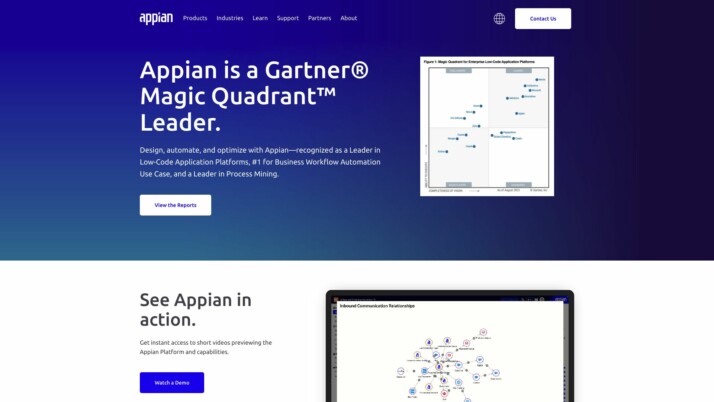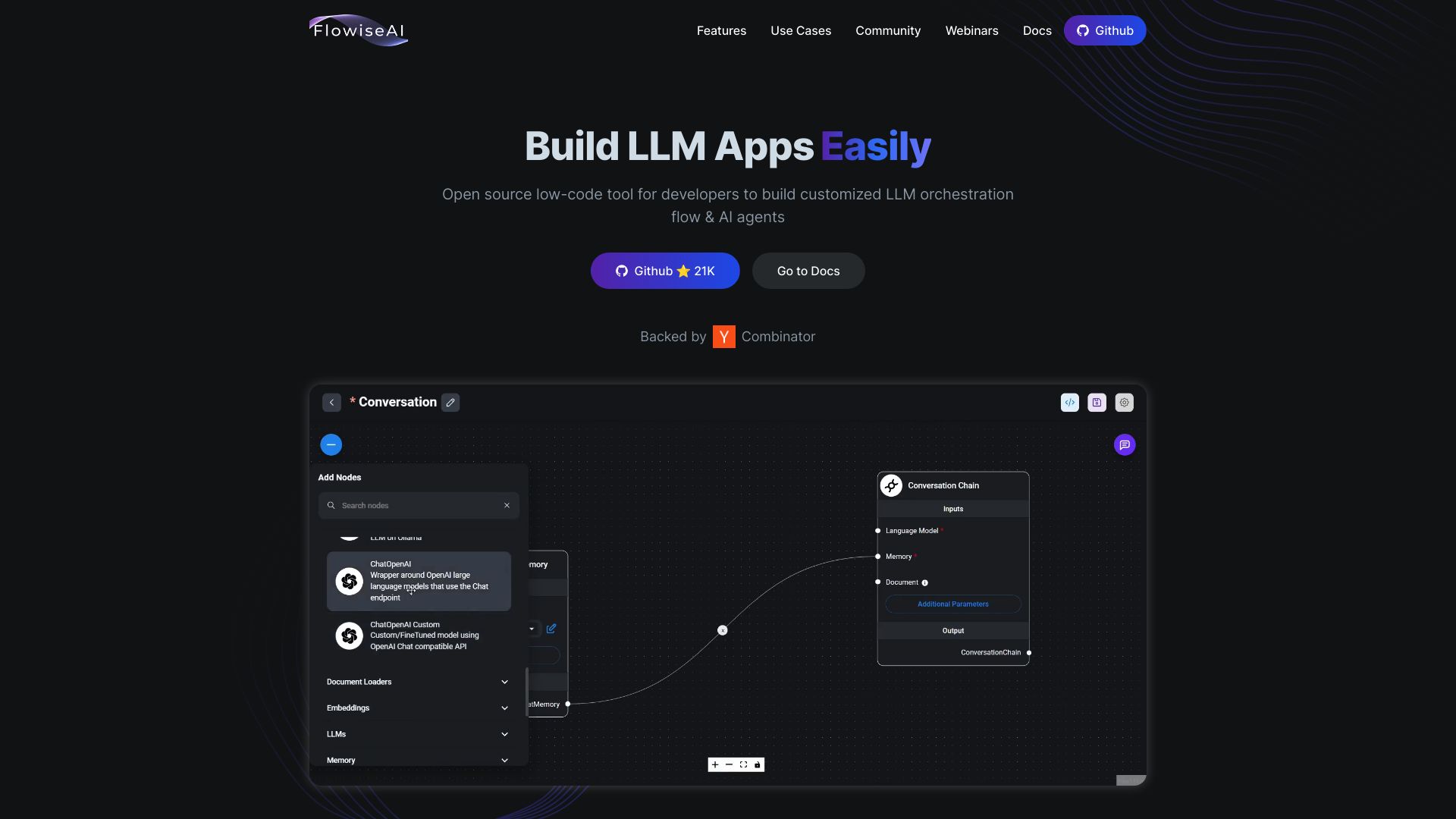Appian vs. FlowiseAI: AI Development Platforms Compared
AI agent builders transform how businesses leverage artificial intelligence, offering powerful tools to create custom AI solutions. This comparison explores Appian vs. FlowiseAI, and SmythOS, three leading platforms revolutionizing AI development. We’ll examine their unique approaches to low-code AI integration, customization capabilities, and enterprise-grade features.
Whether you’re a seasoned developer or a business leader exploring AI adoption, this analysis will help you navigate the strengths and limitations of each platform. Discover how these tools democratize AI, enhance workflow automation, and enable rapid prototyping of sophisticated AI applications.
Appian Overview
Appian empowers organizations to harness artificial intelligence through its low-code platform. The software integrates AI capabilities into business workflows, enabling rapid development and deployment of intelligent applications without extensive coding expertise.


Appian’s AI toolkit includes pre-built models for document processing, email classification, and generative AI tasks. These out-of-the-box solutions accelerate implementation of AI-driven automation across industries. The platform also supports custom AI model creation, allowing organizations to tailor solutions to their specific needs.
Appian empowers organizations to harness artificial intelligence through its low-code platform… enabling rapid development and deployment of intelligent applications without extensive coding expertise.
Key strengths include Appian’s emphasis on data privacy and security. AI models and data remain under customer control, addressing concerns in regulated industries. The platform integrates with existing enterprise systems and scales to handle large-scale deployments.
While powerful, Appian’s approach focuses primarily on enhancing business process automation rather than providing a general-purpose AI development environment. The platform excels at embedding AI into workflows but may have limitations for users seeking to build standalone AI agents or explore cutting-edge AI research applications. Additionally, the low-code paradigm, while accessible, can constrain advanced users requiring fine-grained control over AI model architectures and training processes.
FlowiseAI Overview
FlowiseAI empowers developers to create customized large language model (LLM) orchestration flows and AI agents through an open-source, low-code platform. This innovative tool simplifies the process of building sophisticated LLM-based applications, making AI development more accessible to a wider range of users.
FlowiseAI’s visual interface stands out as a key feature, offering drag-and-drop functionality that enables rapid prototyping and deployment of AI solutions. Developers can design complex workflows without deep technical expertise in AI, significantly reducing the learning curve associated with LLM application development. The platform’s modular approach, utilizing an agent and chain system, allows users to link various components such as document loaders, text splitters, and LLMs to create tailored AI processes.
FlowiseAI empowers developers to create customized large language model (LLM) orchestration flows and AI agents through an open-source, low-code platform.
Integration capabilities form another cornerstone of FlowiseAI’s offerings. The platform supports a diverse array of document loaders, vector databases like Pinecone, and various data types including PDFs, web pages, and CSV files. This versatility makes FlowiseAI adaptable to numerous use cases, from document analysis to customer support applications. The inclusion of pre-built templates further accelerates development, providing users with starting points for common AI tasks.


While FlowiseAI offers robust features for AI development, its open-source nature presents both advantages and challenges. The platform benefits from community contributions and transparency, potentially leading to rapid improvements and innovative features. However, this also means that enterprise-grade support and certain advanced features common in proprietary solutions might be limited. Users should consider their specific needs and resources when evaluating FlowiseAI against other AI agent builders.
FlowiseAI’s vision of democratizing AI development aligns with the growing demand for accessible AI tools.
FlowiseAI’s vision of democratizing AI development aligns with the growing demand for accessible AI tools. By lowering the barrier to entry for AI application creation, the platform enables more individuals and organizations to harness the power of large language models. This approach positions FlowiseAI as a valuable tool for various industries looking to implement AI solutions, from startups to established enterprises seeking to innovate their processes.
Feature Comparison
Appian and FlowiseAI offer distinct approaches to AI agent development, with key differences in their core components and security features. Appian provides a robust low-code platform with built-in AI capabilities, focusing on enhancing business process automation. It excels in document processing, email classification, and integrating AI into existing enterprise workflows. Appian’s strength lies in its emphasis on data privacy and security, ensuring AI models and data remain under customer control.
FlowiseAI, as an open-source solution, offers greater flexibility for customization but may lack some of the enterprise-grade features of Appian. FlowiseAI’s visual interface allows for rapid prototyping of LLM-based applications, making it more accessible for developers with varying levels of AI expertise. However, it may not match Appian’s depth in areas like audit logging, scalability for large enterprises, or pre-built AI skills for specific business processes.
In terms of security, Appian’s focus on regulated industries gives it an edge with features like data encryption and robust access controls. FlowiseAI, while flexible, may require additional configuration to meet stringent enterprise security standards. This gap highlights the trade-off between Appian’s enterprise-ready solution and FlowiseAI’s open-source adaptability.
Feature Comparison Table
| Appian | FlowiseAI | SmythOS | |
|---|---|---|---|
| CORE FEATURES | |||
| Hosted Agents (Dev, Production) | ❌ | ❌ | ✅ |
| Environments (Dev, Production) | ✅ | ❌ | ✅ |
| Autonomous Agents | ❌ | ✅ | ✅ |
| Debug Tools | ✅ | ❌ | ✅ |
| Multi-Agent Collaboration | ❌ | ❌ | ✅ |
| Audit Logs for Analytics | ✅ | ❌ | ✅ |
| Work as Team | ✅ | ❌ | ✅ |
| Agent Work Scheduler | ❌ | ✅ | ✅ |
| SECURITY | |||
| Constrained Alignment | ✅ | ❌ | ✅ |
| OAuth | ✅ | ❌ | ✅ |
| IP Control | ✅ | ❌ | ✅ |
| COMPONENTS | |||
| Foundation AIs | ❌ | ✅ | ✅ |
| Huggingface AIs | ❌ | ✅ | ✅ |
| Zapier APIs | ❌ | ❌ | ✅ |
| Classifiers | ✅ | ❌ | ✅ |
| Data Lakes | ✅ | ❌ | ✅ |
| DEPLOYMENT OPTIONS (EMBODIMENTS) | |||
| Staging Domains | ✅ | ❌ | ✅ |
| Production Domains | ✅ | ❌ | ✅ |
| Deploy as Site Chat | ❌ | ✅ | ✅ |
| Deploy as Scheduled Agent | ❌ | ❌ | ✅ |
| Deploy as GPT | ❌ | ✅ | ✅ |
| DATA LAKE SUPPORT | |||
| Hosted Vector Database | ❌ | ❌ | ✅ |
| Sitemap Crawler | ❌ | ❌ | ✅ |
| YouTube Transcript Crawler | ❌ | ❌ | ✅ |
| URL Crawler | ❌ | ✅ | ✅ |
| Word File Support | ✅ | ❌ | ✅ |
Best Alternative to Appian and FlowiseAI
SmythOS stands out as the superior alternative to Appian and FlowiseAI, offering a comprehensive AI agent development platform that combines power, flexibility, and ease of use. Our drag-and-drop interface simplifies the creation of complex AI workflows, making advanced AI capabilities accessible to users with varying levels of technical expertise.
Unlike Appian’s focus on business process automation or FlowiseAI’s open-source approach, SmythOS provides a versatile ecosystem for building and deploying AI agents across a wide range of use cases. We offer seamless integration with numerous AI models, APIs, and data sources, allowing users to create sophisticated AI solutions tailored to their specific needs.
SmythOS excels in areas where Appian and FlowiseAI fall short. Our platform supports autonomous agents, multi-agent collaboration, and advanced debugging tools, enabling the development of more intelligent and efficient AI systems.
SmythOS excels in areas where Appian and FlowiseAI fall short. Our platform supports autonomous agents, multi-agent collaboration, and advanced debugging tools, enabling the development of more intelligent and efficient AI systems. We also provide robust security features, including data encryption and OAuth support, ensuring that your AI solutions meet enterprise-grade standards.
One of SmythOS’s key advantages is its flexibility in deployment options. Whether you need to deploy your AI agents as APIs, chatbots, scheduled tasks, or even GPT models, our platform accommodates a diverse array of deployment scenarios. This versatility, combined with our scalable infrastructure, makes SmythOS an ideal choice for businesses of all sizes, from startups to large enterprises.
By choosing SmythOS, you gain access to a cutting-edge AI development platform that offers the best of both worlds: the power and security of enterprise-grade solutions like Appian, and the flexibility and innovation of open-source platforms like FlowiseAI. Our commitment to providing a user-friendly, feature-rich environment for AI agent development makes SmythOS the clear choice for organizations looking to harness the full potential of AI technology.
Conclusion
Appian and FlowiseAI offer unique approaches to AI development, each with distinct strengths. Appian excels in enterprise-grade solutions, providing robust security features and pre-built AI capabilities tailored for business process automation. Its low-code platform makes AI integration accessible, particularly for organizations in regulated industries. FlowiseAI, as an open-source tool, offers greater flexibility and customization options, appealing to developers seeking to build tailored LLM applications quickly.
However, SmythOS emerges as the superior choice, combining the best of both worlds and offering additional advantages. Our platform provides unparalleled versatility with its “Create Once, Deploy Anywhere” philosophy, allowing seamless integration across multiple environments. SmythOS’s drag-and-drop interface rivals FlowiseAI’s ease of use while offering enterprise-grade security comparable to Appian. Unlike its competitors, SmythOS supports multi-agent collaboration and offers an extensive integration ecosystem of over 300,000 connections, far surpassing the capabilities of both Appian and FlowiseAI.
While Appian and FlowiseAI may suit specific use cases, SmythOS stands out as the comprehensive solution for businesses seeking to harness the full potential of AI. Our platform not only matches the strengths of its competitors but also offers unique features like advanced deployment options, multi-modal support, and scalable architectures. This makes SmythOS the ideal choice for organizations looking to innovate and streamline their AI development processes.
To experience the power of SmythOS firsthand, we invite you to explore our diverse range of AI-powered agent templates. These templates cover multiple business categories and are designed to jumpstart your AI journey. For those ready to dive deeper, create a free SmythOS account and start building unlimited AI agents at no cost. Discover how SmythOS can revolutionize your approach to AI development and deployment, offering a future-proof solution that grows with your needs.
Last updated:
Disclaimer: The information presented in this article is for general informational purposes only and is provided as is. While we strive to keep the content up-to-date and accurate, we make no representations or warranties of any kind, express or implied, about the completeness, accuracy, reliability, suitability, or availability of the information contained in this article.
Any reliance you place on such information is strictly at your own risk. We reserve the right to make additions, deletions, or modifications to the contents of this article at any time without prior notice.
In no event will we be liable for any loss or damage including without limitation, indirect or consequential loss or damage, or any loss or damage whatsoever arising from loss of data, profits, or any other loss not specified herein arising out of, or in connection with, the use of this article.
Despite our best efforts, this article may contain oversights, errors, or omissions. If you notice any inaccuracies or have concerns about the content, please report them through our content feedback form. Your input helps us maintain the quality and reliability of our information.
